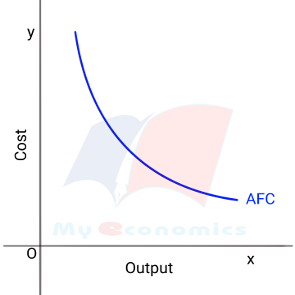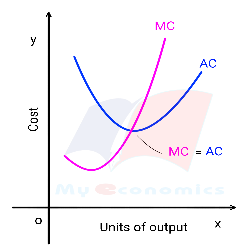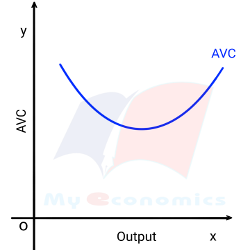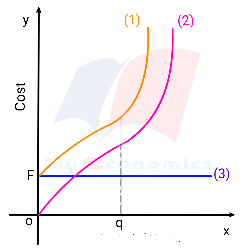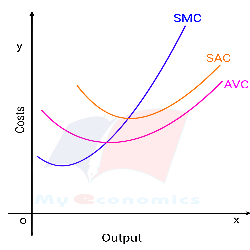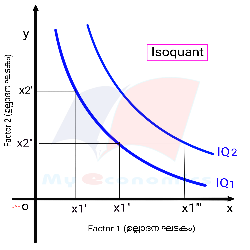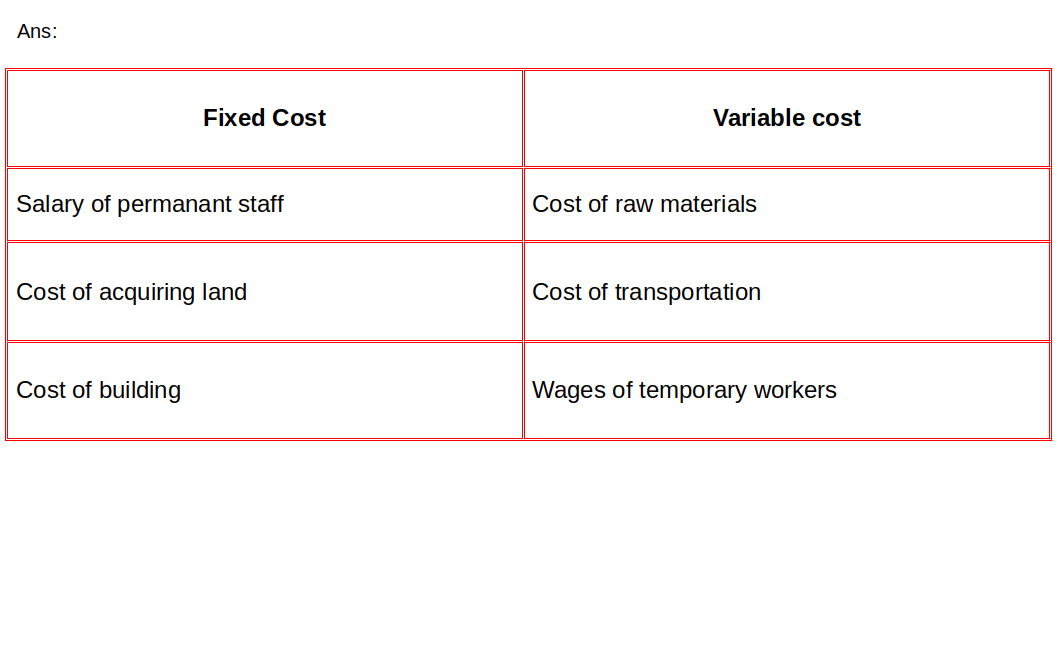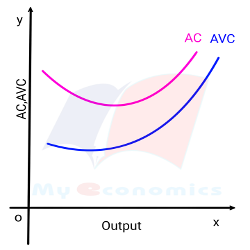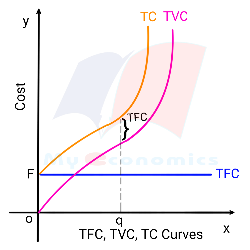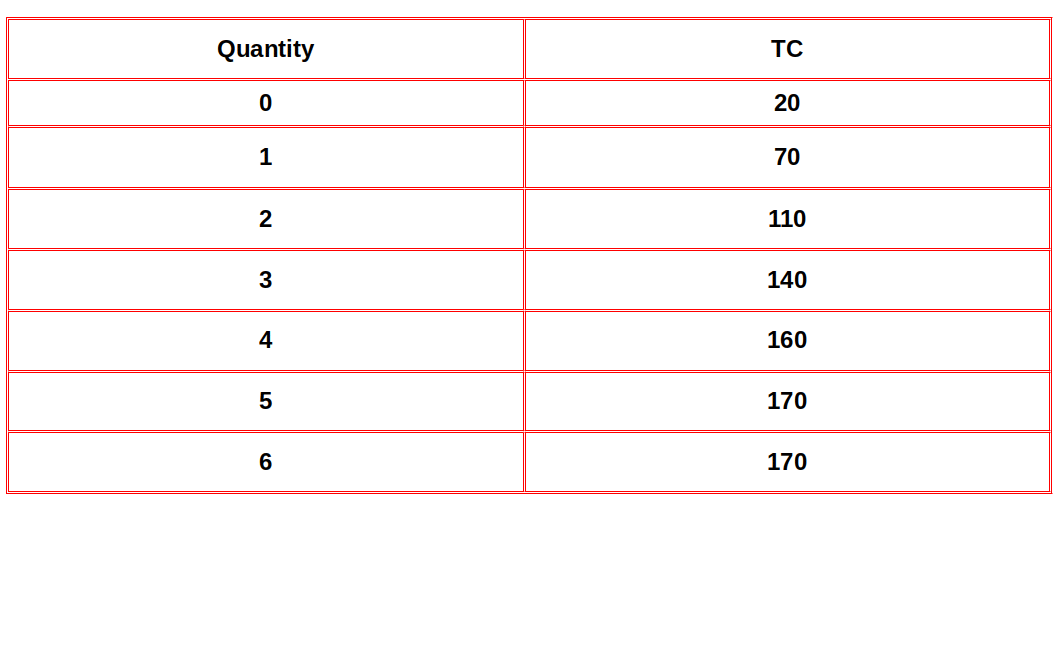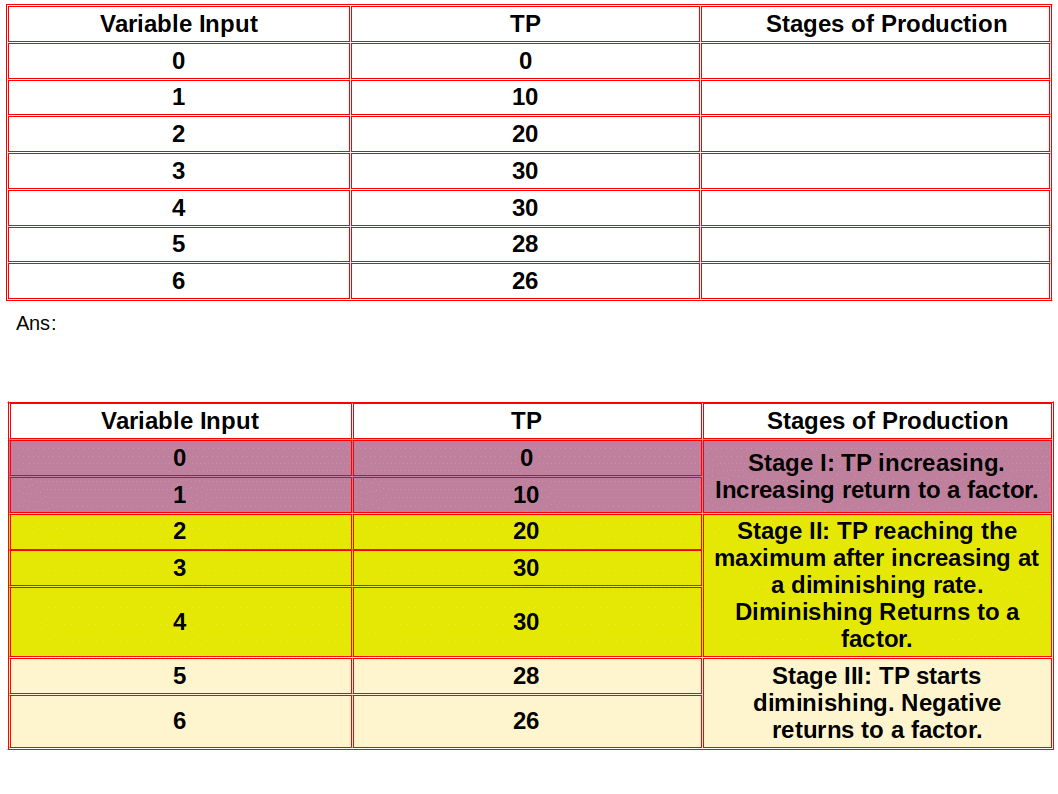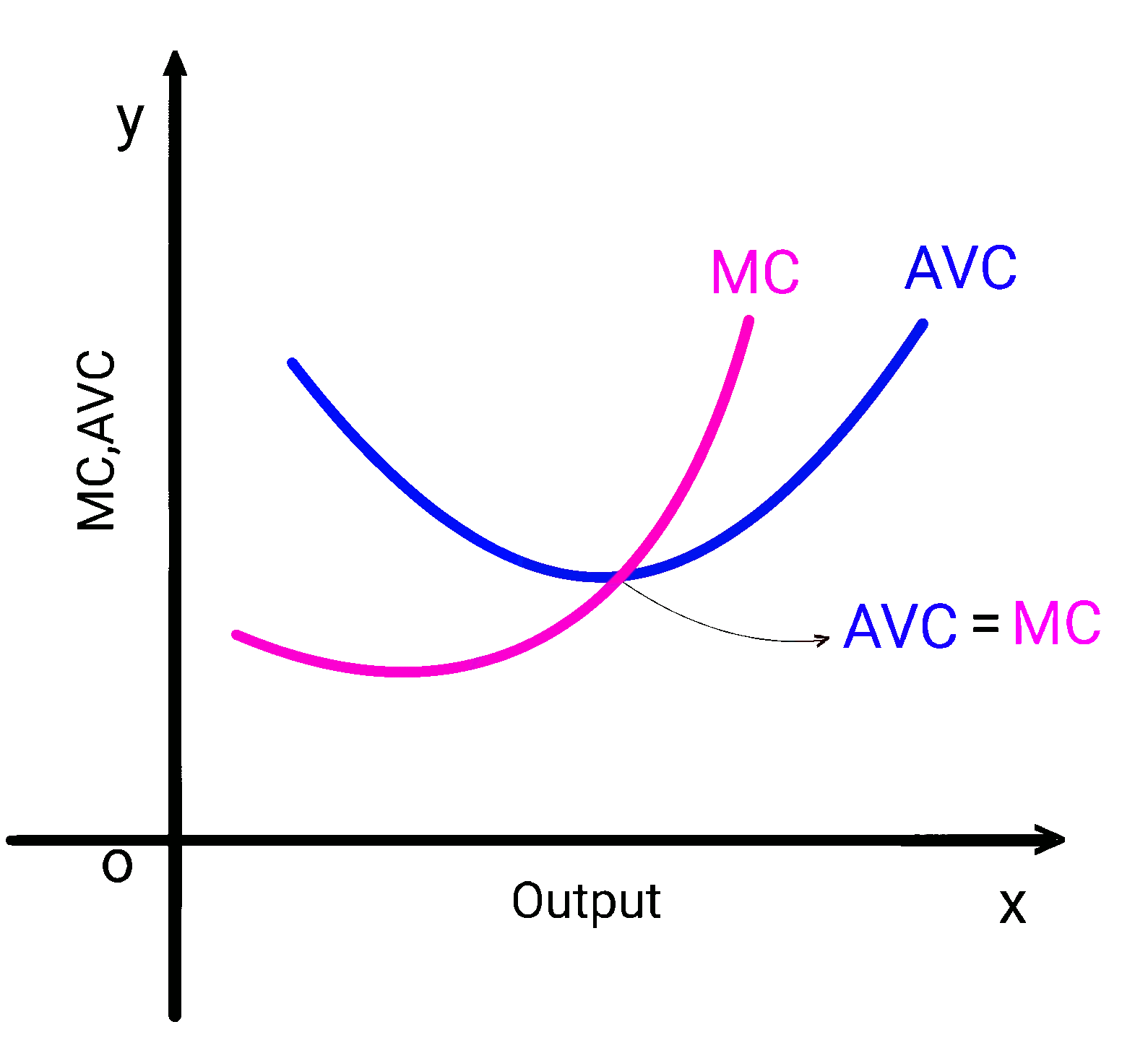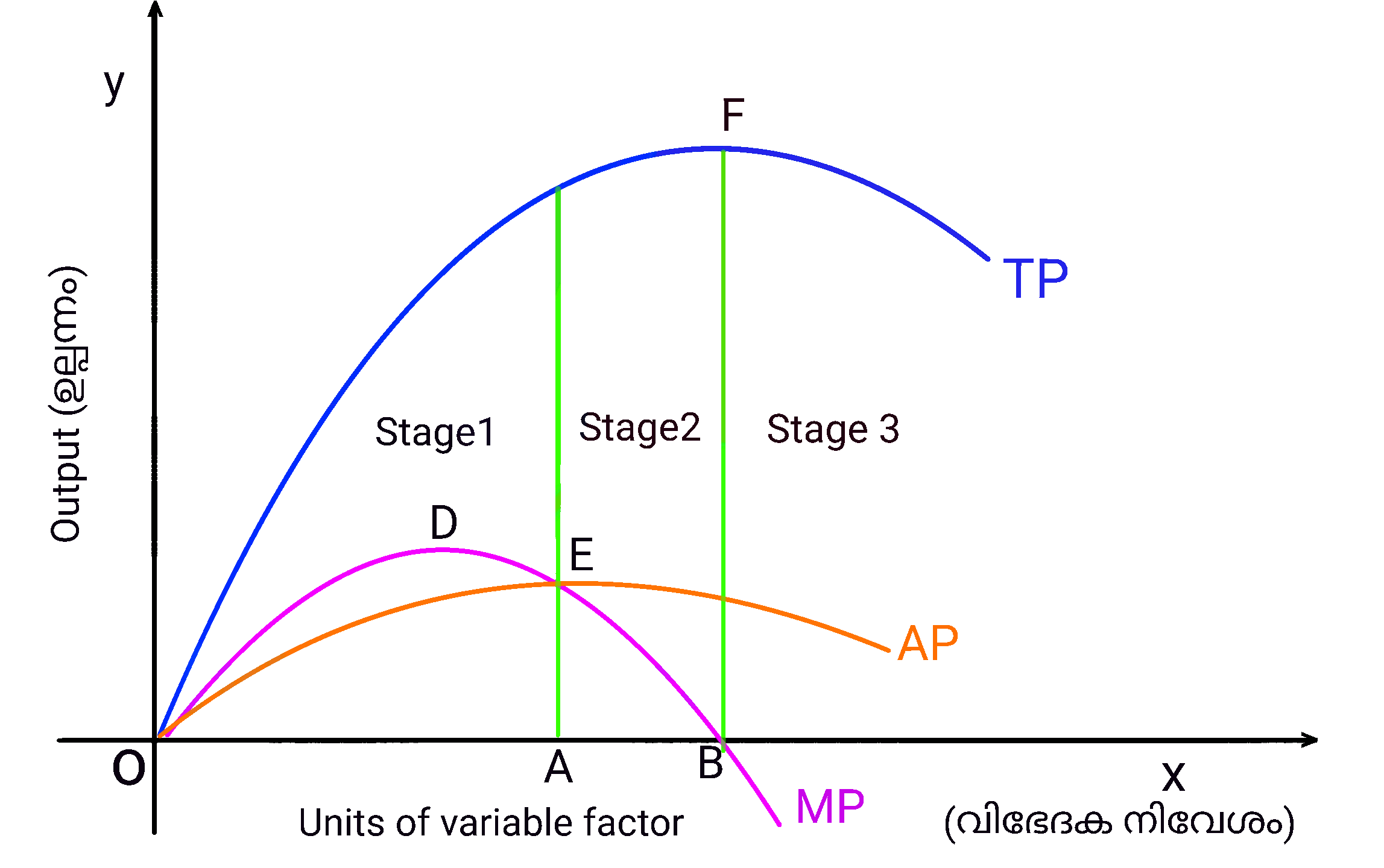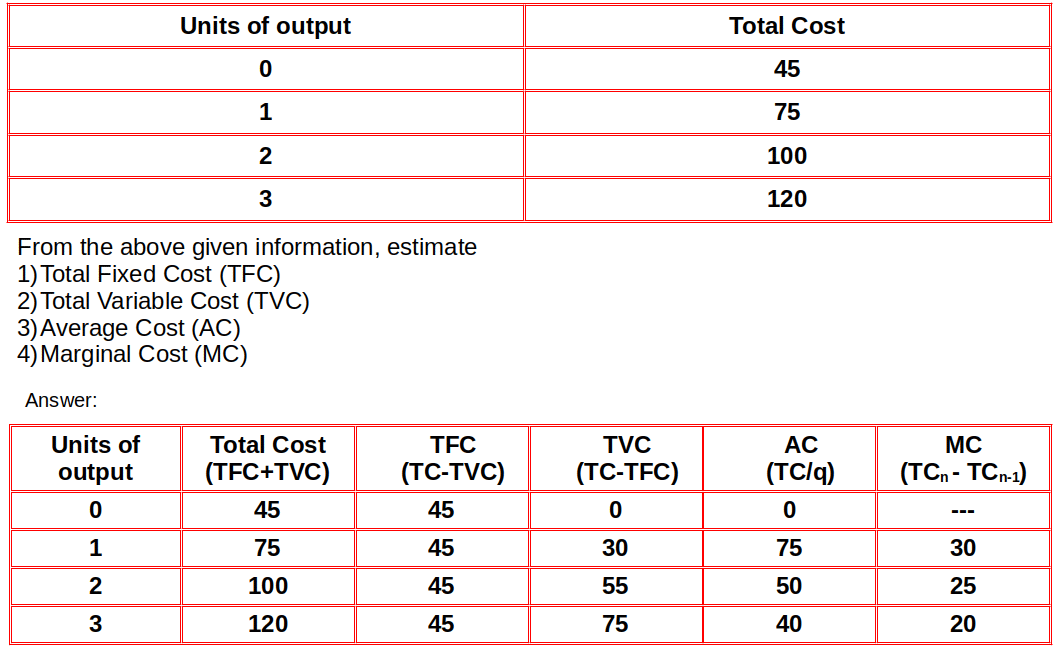Chapter 3 Production and Cost
Multi choice questions
- A set of all the combinations of the two inputs that yield the same level of output is
- Isoquant .
- PPC .
- Isocost line .
- Indifference Curve .
- AC (average cost) is the sum of AFC (average fixed cost) and
- MC .
- AC.
- TVC.
- AVC .
- TFC = AFC x
- TFC .
- TVC.
- AVC.
- Q .
- Addition to the total product is called
- MP (Marginal Product) .
- AP (Average Product).
- TP (Total Product).
- None of these .
- All inputs can be varied in the
- Short run .
- Long run.
- Long run and Short run.
- None of the above .
- The shape of AFC curve is
- ‘ U ‘ shape .
- Inverted ‘ U ‘ shape .
- Rectangular Hyperbola.
- ‘ L ‘ shape .
- If input is doubled and output become double, the production function is
- IRS .
- CRS .
- DRS .
- None of the above .
- Which of the following cost will be zero when production is stopped ?
- AFC .
- Total Cost .
- Fixed Cost .
- Variable Cost .
- The relationship between input and output is called
- Utility function .
- Production function .
- Demand function .
- Consumption function .
- TP at 5th unit of labour is 16 and TP at 6th uit of labour is 18, then MP is
- 34 .
- 11 .
- 2 .
- 1 .
- α + β = 1 in the Cobb-Douglas production function exhibits
- IRS .
- CRS .
- DRS .
- None of the above .
- When a firm increased the number of labour from 10 to 11, keeping the capital fixed the total product increased from 120 to 130. Which of the following is statement is correct in this regard ?
- The total product fell .
- This is a long run production .
- The average product is rising .
- 10 is the marginal product of an increased unit of labour .
- Identify the shape of the following AFC curve
- ‘ U ‘ shape .
- ‘ L ‘ shape .
- Rectangular Hyperbola .
- None of the above .
- Slope of an isoquant is
- Marginal cost .
- DMRS .
- DMRTS .
- None of the above .
- \( \mathbf{\frac{ΔTC}{ΔQ}} = \)
- AC .
- FC .
- MC .
- AVC .
- When MP becomes zero, TP
- Increases .
- Decreases .
- Becomes negative .
- Becomes Maximum .
- α + β > 1 in the Cobb-Douglas production function exhibits
- IRS .
- CRS .
- DRS .
- None of the above .
- All the following curves are ‘U’ shaped except
- The AFC curve .
- The AVC curve .
- The AC curve .
- The MC curve .
- Increasing returns, Diminishing returns, Negative returns, Returns to scale.
- $$ a) {AC =\frac{TC}{Q}}, $$
$$ b) {AFC =\frac{TFC}{Q}} ,$$
$$ c) {AVC =\frac{MC}{Q}} ,$$
$$ d) {SAC =\frac{TC}{Q}} $$
- Wages for own labour, Rent for own land, Interest for own capital, Energy cost.
- TP, MP, AP, MC.
- TVC, TFC, LAC, AFC.
- LAC, DRS, CRS, IRS.
- AFC, MRS, SMC, MPP.
- Given below is the average cost curve of a fim. Draw the marginal cost curve showing the relationship between AC and MC.
- TFC of a firm is ₹2000. Its TVC is ₹3000. It produces 20 units . Calculate the AVC and AC of the firm.
- Find TP.
- Find AP and MP on the basis of TP
- Find TP and AP on the basis of MP
- Let the production function of a firm be q = 5L½K½.Find the maximum output that the firm can produce with 100 units of L and 100 units of K.
- ” In the long run all costs are variable ” Do you agree with this statement ?.
- ” The AVC is ‘ U ‘ shaped ” explain the reason for the ‘ U ‘ shape of AVC curve. Also draw a diagram to clarify your points.
- Let the production function of a firm be q = 10L½K½.Find the maximum output that the firm can produce with 100 units of L and 100 units of K.
- Prove that AC is the sum of AFC and AVC.
- The table given below shows the total product schedule of labour. Determine the AP and MP of labour.
- Can there be some fixed cost in the long run ?.
- Identify the following curves.
- TC.
- TVC.
- TFC .
- Identify the shapes of the following cost curves
(a.) AFC (b.) AC (c.) TFC (d.) TVC (e.) TC.
- Rectangular hyperbola .
- ‘ U ‘ shape .
- Straight line parallel to X axis .
- Inverse ‘S’ shape .
- Inverse ‘S’ shape .
- Identify the following curves.
- What do you mean by an Isoquant ?.
- There exists vertical distance between (a) TVC and TC (b) TC and TFC. What does this distance indicates ?.
- The vertical distance between TVC and TC represents the total fixed cost (TFC) .
- The vertical distance between TC and TFC represents the total variable cost (TVC) .
- Categorise the following in to fixed cost and variable cost.
- Cost of acquiring land.
- Cost of raw materials .
- Salary of permanent staff .
- Cost of transportation .
- Cost of building .
- Wages of temporary workers .
- Match the following
- With the help of a diagram show the relation between average cost and average variable cost.
- In the short run, total variable cost (TVC) is zero when output is zero. When output rises, total cost (TC) also rises. Draw a suitable diagram and explain the relarionship between total fixed cost (TFC), total variable cost (TVC) and total cost (TC) .
- The following table shows the total cost (TC) schedule of a firm. Calculate TVC, AFC, AVC, SAC, and SMC schedules.
- From the table , examine the different levels of TP and identify the different phases of the operation of the Law of Variable Proportion.
- “Increased use of fertilizers in the paddy cultivation without employing additional laborers leads to a fall in the output after a particular stage”. Discuss the law of production related to this situation.
- Differentiate the term short run and long run.
- “Raghu is a farmer who produces paddy in his 10 acres of land. He is trying to increase his total output by increasing the quantity of only one of his input-say labour” Which law explains this situation? What will be the effect on his total output when only labour increases? Give your suggestions to him with a suitable diagram.
- Find out maximum possible output for a firm with zero (0) units of labour and 10 units of capital when production function is q = 5L + 2K.
- Short run MC and AVC curves are U shaped. Write down the relationships between SMC and AVC by drawing diagram.
- AVC and MC initially fall and later rises.
- When AVC falls, MC will be less than AVC.
- When AVC rises, MC will be more than AVC.
- When AVC is minimum, MC = AVC .
- MC cuts AVC at the minimum point.
- ” Short run production functions are fixed proportion production functions.” Do you agree with this statement? Substantiate.
- The following diagram represents TP, MP and AP curves of a firm. After studying the curves, answer the questions given below.
- When does TP become maximum?
- At what rate ( increasing or decreasing) does TP increase when MP increases ?
- When does MP become negative?
- TP will be maximum at the point where MP becomes zero.
- When MP increases, TP increases at an increasing rate.
- MP becomes negative, when TP starts diminishing.
- Production information about a firm is given below.
Answer:
A. Isoquant
Answer:
D. AVC
Answer:
D. Q
Answer:
A. MP (Marginal Product)
Answer:
B. Long run
Answer:
C. Rectangular Hyperbola
Answer:
B. CRS(Constant Return to Scale)
Answer:
D. Variable Cost
Answer:
B. Production function
Answer:
C. 2
Answer:
B. CRS(Constant Return to Scale)
Answer:
D. 10 is the marginal product of an increased unit of labour .
Answer:
C. Rectangular Hyperbola .
Answer:
C. DMRTS (Diminishing Marginal Rate of Technical Substitution)
Answer:
C. MC
Answer:
D. Becomes Maximum
Answer:
A. IRS(Increasing Return to Scale)
Answer:
A. The AFC curve
Find the odd one out
Answer:
Returns to scale. Others are different stages of Law of Variable Proportions.
Answer:
\( c) {AVC =\frac{MC}{Q}} \)This is a wrong equation .
Answer:
Energy costs. Others are implicit cost.
Answer:
MC, MC related with cost.
Answer:
LAC, others represents short run costs.
Answer:
LAC, LAC related with cost.
Answer:
AFC .
Answer:
Answer:
TC = TFC + TVC = 2000 + 3000 = 5000 .
$$ {AC =\frac{TC}{Q}}, $$
$$ {=\frac{5000}{20}} ,$$
$$ { ={250}} $$
$$ {AVC =\frac{TVC}{Q}}, $$
$$ {=\frac{3000}{20}} ,$$
$$ { ={150}} $$
Answer:
The production function is q = 5L½K½. Since the firm uses 100 units of L and 100 units of K, we get the production function as
q = 5 × 100½100½
q = 5 × 10 × 10
q = 5 × 100 = 500.
Answer :
Yes. In the long run costs are variable. This is because there is sufficient time available in the long run for any factor of production to get increased. As there are only variable factors in the long run, all costs are variable.
Answer :
The SMC and AVC curves start rising when production start. As output increases, SMC falls. AVC being the average of marginal cost also falls but falls less than SMC. Then after a point, SMC start rising. AVC however, continues to fall as long as value of SMC remains less than the prevailing value of AVC. Once the SMC has risen sufficiently its value becomes greater than the value of AVC. The AVC starts rising. Therefoe the AVC curve is ‘ U ‘ shaped. It is shown in the given below diagram.
Answer:
The production function is q = 10L½K½.
Since the firm uses 100 units of L and 100 units of K, we get the production function as
q = 10 × 100½100½
q = 10 × (102)½ × (102)½
q = 10 × 10 × 10 = 1000.
Answer :
$$ {AC =\frac{TC}{Q}}, $$
Where TC = TFC + TVC so that,$$ {AC =\frac{TFC + TVC}{Q}} ,$$
$$ {AC =\frac{TFC}{Q}} + {\frac{TVC}{Q}} $$
We know that $$ {=\frac{TFC}{Q}} = AFC $$ and
$$ { \frac{TVC}{Q}} = AVC$$ therefore AC = AFC + AVC
Answer :
Answer :
No, there can not be some fixed cost in the long run. This is because, in the long run all factors of production can be adjusted and variable.
Answer :
Answer :
Answer :
Answer :
An isoquant is the set of all possible combinations of the two inputs that yield the same maximum possible level of output. Each isoquant represents a particular level of output and is labelled with that amount of output. The shape of isoquant is drawn below.
Answer :
Answer :
Both AC and AVC are ‘U’ shaped. As the output increases the gap between AC and AVC narrows.
Answer:
In the above diagram, product (q) is marked x-axis and cost is marked on y-axis. TFC curve is parallel to x-axis. TVC curve starts from the origin of axis because when output is zero TVC is also zero. Both TC and TVC curves sloping upwards. They have an inverted shape. The gap between TC and TVC is equal to TFC.
Answer:
Answer:
“Increased use of fertilizers in the paddy cultivation without employing additional laborers leads to a fall in the output after a particular stage”.This law of production is the Law of Diminishing Returns to a factor. This is also known as Law of Variable Proportion stage. That is, when more and more units of variable factor are added with fixed factors, after a stage, TP increases at diminishing rate and then decreasing. MP diminishing after a particular stage, then reached zero to negative.
Answer:
Short run is a period in which the firm cannot vary all the inputs. Thus in the short run there are Variable inputs (variable factor) and Fixed inputs (fixed factor).
Long run is the period in which the firm can vary all inputs. thus in the long run, all inputs are variable.
Answer:
“Raghu is a farmer who produces paddy in his 10 acres of land. He is trying to increase his total output by increasing the quantity of only one of his input-say labour”.This situation explains the Law of Variable Proportion or Law of Increasing returns to a factor . Here, his total output at first increases at an increasing rate, then increases at a diminishing rate, then reaches maximum. After a particular stage, TP starts diminishing.
Answer:
Given production function is q = 5L + 2K.
L = 0, K = 10
∴ q = 5 × 0 + 2 × 10
q = 0 + 20 = 20
q = 20 is the maximum possible output that the firm can produce.
Answer:
Answer:
No, I disagree with this statement ” Short run production functions are variable proportion production functions “, because in the short run, some factors are fixed and some are variable. Hence application of one variable factor with fixed factors causes change in the input proportion.i.e., the proportion between inputs are not fixed. It is variable. Only long run production functions are known as fixed proportion production functions.


